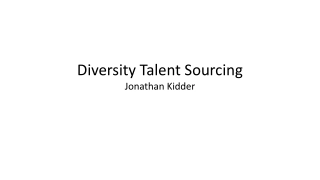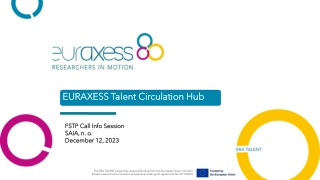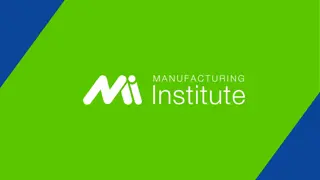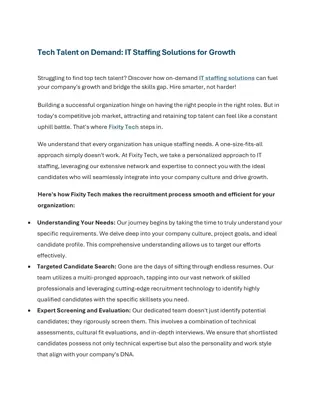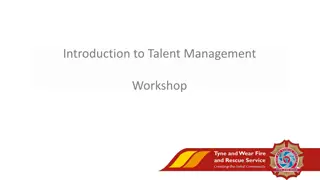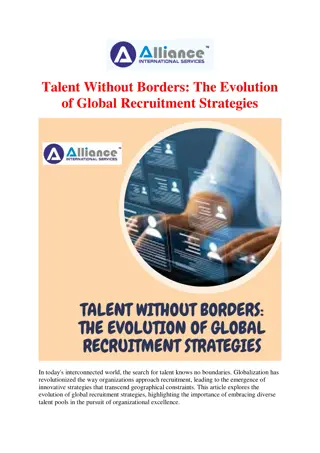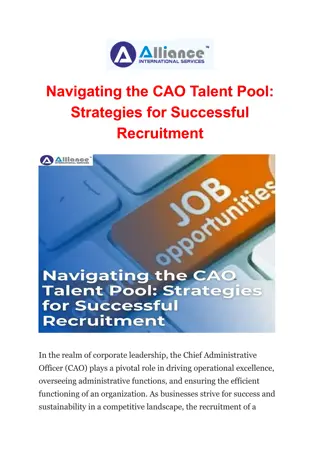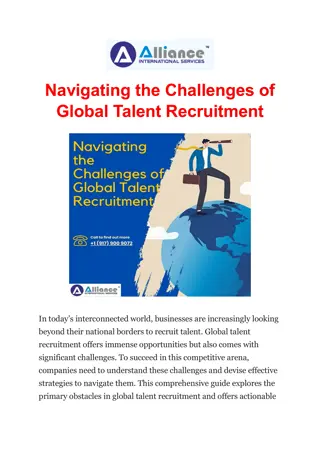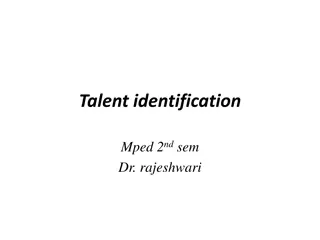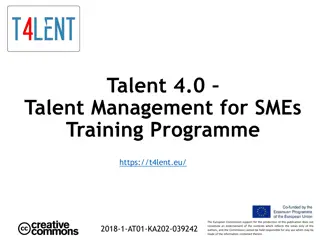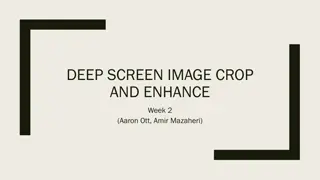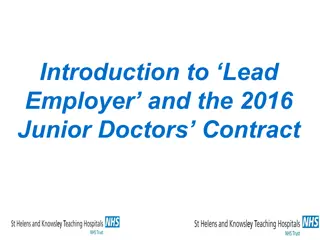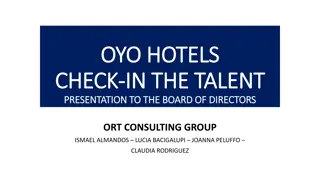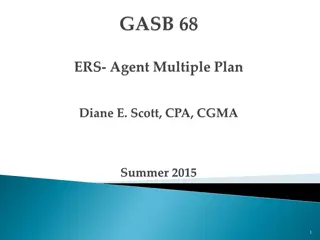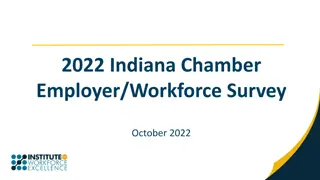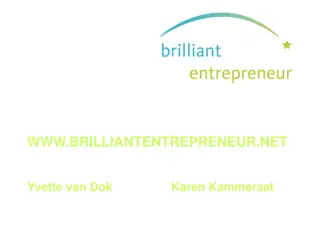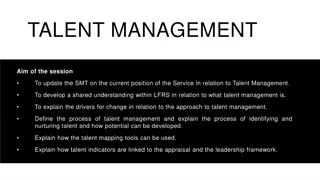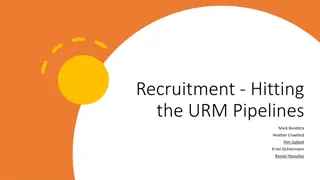Effortlessly Attracting the Right Talent: An Employer Image Building Methodology
Building a strong employer image is vital in attracting top talent. Learn the step-by-step plan to develop a compelling Employer Value Proposition (EVP) and execute successful recruitment campaigns. Debriefing, strategy implementation, and achieving objectives are all covered in this comprehensive guide to effortlessly attracting the right talent.
Uploaded on Mar 04, 2025 | 0 Views
Download Presentation

Please find below an Image/Link to download the presentation.
The content on the website is provided AS IS for your information and personal use only. It may not be sold, licensed, or shared on other websites without obtaining consent from the author.If you encounter any issues during the download, it is possible that the publisher has removed the file from their server.
You are allowed to download the files provided on this website for personal or commercial use, subject to the condition that they are used lawfully. All files are the property of their respective owners.
The content on the website is provided AS IS for your information and personal use only. It may not be sold, licensed, or shared on other websites without obtaining consent from the author.
E N D
Presentation Transcript
PART FOUR The Physical Sciences
Careers in Physical Sciences Chemist- involved in food products, cosmetics, fuels, household products, industry, pollution control, weapons, drugs Physicist- studies forces and energy; theoretical branch studies space and time, black holes, stars Engineer- applies physical science knowledge to the development of products and procedures that solve human problems
Key Events in the Development of the Physical Sciences (pages 338-339) Date 440 B.C. Scientist Democritus Event Used word atom 260 B.C. Archimedes Lever & buoyancy 1581 Galileo Pendulum, mass & acceleration Elements are made of atoms Atomic chart 1808 Dalton 1862 Mendelev 1897 Curie Radioactivity 1905 Einstein Law of mass/energy conservation
Women and Men Who Have Shaped the Development of the Physical Sciences Newton Curie Yalow Volta Rutherford Gell-Mann Faraday Einstein Weinberg Byron Bohr Hawking Edison Hopper Latimer Shiung Wu Woods Franklin
Personal and Social Implications of the Physical Sciences Personal and Community Health Medicines, instruments, environmental studies Hazards, Risks, and Benefits Work on decreasing the degradation of natural resources Personal safety for workers Surveillance techniques
Physical Science Technology: Its Nature and Impact The Design of Physical Science Technology Engineers develop measuring devices, materials, & tools that meet a set of criteria. Examples of Physical Science Technology Radiation measuring devices Lasers Computers Spectrophotometers Chemical reagents Wind Tunnels Long-Term Implications of Physical Science Technology Reducing pain and suffering (medicines), brand new materials, communications (computers, Internet, cell phones), robotics,
Chapter 16 Matter and Motion Content From Atoms to Rockets and Other Technological Wonders Matter- anything that has mass and takes up space: matter & energy (the ability to do work) make up the universe; all matter has attractive force on other matter (gravity); main elements on earth: O, Si, Al, Fe, Ca, Na, K, Mg, H, C The Physical Properties of Matter Three states; solids (have a definite shape), liquids (have a definite volume), gases (do not have a definite shape or volume- can be compressed) Density: mass per unit volume (how heavy an object is for its size
Kinetic Molecular Theory Matter can be changed from one state to another; this can be explained by the motion of molecules. Physical change- No new substance is formed (ex. ice melting). Examples: Evaporation/condensation Contraction/ expansion Chemical Changes in Matter- A new substance is formed different from the original substance- signs are: change in color, temperature, or a gas is given off). Ex.: Magnesium bright light in flame (sparkler), iron rusting, burning of paper The Roasting of a Marshmallow Fire- carbon combines with oxygen; kindling temperature, combustion
Elements, Compounds, and Mixtures Element- cannot be separated (C,O,H,N) Compound-two or more elements chemically combined (NaCl) Terms; Atoms (basic building block of matter), molecules (has shared atoms), chemical equations- describe changes in matter Mixture- Any combination of materials that can be separated easily from one another, not chemically combined (ex. sand & salt).
The Parts of an Atom Terms: electrons (negative charge outside of nucleus (in shells)- enter into chemical reactions), nucleus- center of atom has protons (positive), neutrons (neutral), atomic number (# of protons), atomic weight (# protons + # neutrons), isotope (neutrons differ, same element) Quarks and Other More Fundamental Parts of Matter Discovered with powerful atom-smashing devices. (Are in protons and neutrons)- 6 kinds (flavors)- up, down, strange, charm, bottom, top; 3 varieties (colors)- red,blue,green Don t worry about this in grades K-6!
Nuclear Energy Energy is released by an atomic nucleus changing. Terms: radiation (atomic particles + energy given off), fission (splitting of an atom), chain reaction (reaction continues like dominoes); Nuclear power uses these concepts. This energy can be used to heat water, make steam, and turn turbines to make electricity. Fusion is the when atoms are joined- it is how the sun gets its energy- hydrogen atoms are fusing to form helium.
Motion Terms; speed (miles per hour); velocity (speed and direction); acceleration (increase in speed) Newton s Laws of Motion 1stLaw: Inertia- an object at rest stays at rest, in motion stays in motion. 2ndlaw: Amount of acceleration varies with the magnitude of the force and the mass of the object. (f= ma) 3rdLaw: For every action, there is an equal and opposite reaction.
Gravity and Motion All masses exert attractive forces: law of gravity- a fundamental law of the universe Jet and Rocket Engines They use Newton s third law: Hot gases in one direction (action) produce thrust (the reaction). Flight Lift causes the plane to rise (Bernouli s principle)- the air going across the upper surface moves faster than the air going across the bottom surface. A region of low pressure forms above the wing, the pressure is greater below the wing, causing an unbalanced upward force. Thrust is the forward motion a reaction force to hot gases expelled from the rear of the engine. Other terms: propeller, drag, elevator, rudder, ailerons.
Chapter 17 Energies and Machines Content How Energy is Transferred Dropping a pencil goes from potential (at rest) to kinetic (in motion) (2 forms of energy) The law of conservation of energy- Energy can change form; the total amount of energy and matter in the universe is neither created nor destroyed. Types of energy: Chemical (used in human body), electrical, solar, mechanical, nuclear, sound, heat, light, fusion Einstein s formula: E = mc 2; matter and energy can be converted to each other (mass is stored energy). Energy in Action: The Segway Human Transporter- converts electrical to kinetic (mechanical) energy; can read minute changes in muscle pressure transmitted by its rider.
Electrical Energy Source of energy: Movement of electrons Static Electricity- (Electrons are rubbed off or transferred, and charges between objects are different; electrons jump to a positive or neutral object). It includes lightning, or a spark from touching a doorknob; it does not travel through wires. Current Electricity It comes form the movement of electrons through a conductor. Terms; Direct current- moves in one direction (using a battery (dry cell), ampere (amp)- measures electrical current), volt-measures electromotive force), alternating current- changes directions (used in home and industry), conductor (electrons can flow easily-like metal, resistance (to the flow of electricity) (ohms), insulators (are not good conductors- offer high resistance to the flow of electrons (wood, plastic, rubber), semiconductors (neither conductors or insulators)- like silicon, are used to make tiny electrical devices that control the flow of electrons (computer chips, Silicon Valley )
Electrical Circuits Electrons travel through a conductor- they leave a source (battery), move through a wire (conductor), lose some energy in a resistance (light bulb), and return to the source. Series circuit- has only one path; if one bulb goes out, they all go out Parallel circuit- has more than one path; if one bulb goes out, the rest stay lit This is usually an important topic in standardized tests (look at any practice sample) from 4th- 11th grades.
Magnets, Generators, and Motors Moving a conductor through a magnetic field can start a flow of electrons. Magnets have two poles N and S; the Earth itself is a magnet- small magnets line up with the earth s poles. Generator- it produces electricity by spinning a coiled conductor between the poles of a magnet. Sources of energy that move the conductor may be water, coal, gas, oil, or nuclear fission. Motor- puts electricity to work to move objects. A current, coil of wire, and permanent magnet are used. The coil becomes a magnet when the current flows, and the N and S poles keep changing and moving the coil.
Sound Energy What causes sound? Vibrating matter that requires a medium for transmission; it travels as a speed of 1100 ft/sec in air or 340 m/sec- is faster in steel and slower in water Terms: medium, compression (vibrations close together), rarefaction (vibrations farther apart), sound wave (a series of compressions & rarefactions- use a Slinky to illustrate, wavelength (distance between sound waves), intensity (strength), pitch (how high or low- rate of vibrations or frequency) Sound Can Be Absorbed or Reflected Reflection = echoes
Light Energy Light travels in waves but does not require a medium. It travels much faster than sound (186,000 miles /sec or 300,000 km/sec) The Reflection and Refraction of Light Terms: Transparent (light passes through), opaque (light does not pass), translucent (some light passes through, refraction (light bends passing through different mediums), reflection (light waves bounce back (ex. A mirror) Lens terms: Convex (thicker in the middle), concave (thicker at the edges), focal point, focal length, real image, virtual image- opticians need knowledge of this topic to construct glasses for nearsighted (can see near), farsighted (can see far), and people with astigmatism (uneven shape to eyeballs) or presbyopia (loss of elasticity of lens in many people over 40 years old- needing reading glasses)
Light, Prisms, and Color Spectrum (Visible light)(ROY G BIV), red is longest wavelength & has least amount of energy, violet shortest & most energy; infrared is longer than we can see and has less energy and ultraviolet is shorter than we can see and has more energy. They are part of the electromagnetic spectrum. A prism is a piece of glass that separates white light into a spectrum (a rainbow)- as light wave is refracted, the light is separated according to wavelengths. The 3 primary light colors are red. green, and blue. Pigments are chemical substances that produce their effects because they absorb some light waves and reflect others- you see the color that is reflected. The 3 primary pigment colors are red, yellow, and blue.
Heat Energy What is Heat? Energy that travels from a warm substance to a cool one, it is the rapid motion of molecules. Terms: temperature, degrees, Celsius (0 freezing, 100 boiling), Fahrenheit (32 freezing, 212 boiling), thermometer (DO NOT USE MERCURY!) * Scientists use Celsius measurements! The local TV weather and Science PSSA s use Fahrenheit! PSSA uses Fahrenheit.
How is Heat Measured? Using calories or kilocalories- the amount of heat needed to raise the temp. of 1 gram of water 1 degree Celsius. BTU (English) amount of heat needed to raise the temp. of 1 pound of water 1 degree Fahrenheit How Do Changes in State Occur? We cause the individual molecules to move more freely and break free of their cohesive forces.
Machines How do they work? They enable us to increase a force (a push or pull) on an object. Terms; effort, resistance, mechanical advantage, efficiency, friction Simple Machines Ex.: lever (1st, 2nd, 3rdclass), wheel and axle, pulley, inclined plane, screw, and wedge Friction: To work, every machine must overcome friction. It retards motion and generates heat. ways to reduce it: ball bearings, oil, lubricant. Some friction is good (it enables us to walk).
Chapter 18 Physical Science Lesson Ideas Unit, Lesson, and Enrichment Starter Ideas
Assessing Prior Knowledge and Conceptions You must find out what students know, don t know, and their incorrect assumptions. Use probes: ask basic questions, do simple activities to discover Ex: Show an ice cube & glass of water- ask What is the difference between these two things? Why is it easier to bike down a hill than up a hill? Show a magnet on a filing cabinet, ask: Why do you think the magnet sticks?
Unit Plan Starter Ideas Ideas Based on the NSE K-8 Content Standards Ex.: Children classify the objects in collections of marbles, blocks, small tiles, and pebbles into categories based on weight, shape, size, color Ex.: Children use permanent magnets to demonstrate attraction, repulsion, presence of poles, and existence of magnetic fields Ex.: Children use tools such as rulers, balances, and thermometers to take, write down, and tell about measurements of a variety of solids and liquids.
Lesson Plan Starter Ideas for Common Curriculum Topics Matter: Infer the characteristics of a small object in a closed box without looking in the box. Energy: Observe that sound waves are produced by objects vibrating in a medium. Force and Motion: Create an illustrated chart identifying the characteristics of six simple machines. Airplane, Jet, Rocket: Write a story about a boy or girl who lives on an imaginary planet that does not have gravity.
WebQuest Starter Ideas The Best Bubble-Making Recipe How Can the Sun Help Heat Our School? Simple Machines in a Bicycle What Is an Atom? Famous African American Inventors How Do Birds Fly? How Does a Light Stick Work? How Does a Battery Work?
Classroom Enrichment Starter Ideas In-Class learning Centers Ex.: Energy Savers Bulletin Boards Ex.: Matter and Its Composition Field Trips Ex.: The Telephone Company Shadow Company Simple Machines on the Playground Television Station
Cooperative Learning Projects Must include: Positive interdependence, individual accountability, and development of group process skills. Starter Ideas Density Detectives School Energy Survey Bridge Building
Chapter 18 Matter and Motion Attention Getters, Discovery Activities, and Demonstrations Attention Getters: Why Do We Need to Wear Safety Belts? Where Does the Water Go? Where Are Wheels? Why Do Mothballs Rise and Fall? Use raisins; mothballs are toxic! Can You Separate Sugar and Sand? What Causes Lift? Marie Curie: Scientist and Humanitarian (Internet)
Discovery Activities Matter and Changes From Gas to Liquid What is Your Squeezing Force? Secret Messages and Chemical Changes Pendulums Heat and the Fizzer
Demonstrations The Toy Car in the Wagon: Pushes and Pulls How Does an Earth Satellite Get Placed in Orbit? Teacher on Wheels: Action and Reaction Forces
Attention Getters How Do Instruments Make Sounds? Do Magnets Pull on All Objects? Why Do Some Machines Need Oil? Can Sound Travel through a Solid Object? What Type of Cup Loses Heat the Fastest? Can You Move a Stream of Water without Touching It? I Am Alfred Nobel (Internet activity)
Discovery Activities (contd) Move Those Loads: Making and Using a Simple Lever Can You Build a No Frills Telephone? Simple Circuits Electrical Conductors and Nonconductors The Ink-Lined Plane
Demonstrations (contd) How Does Heating and Cooling Change a Balloon? Tuning Forks Need Food for Thought You Could Hear a Pin Drop: The Conduction of Heat Making Work Easier: Using Fixed and Movable Pulleys


